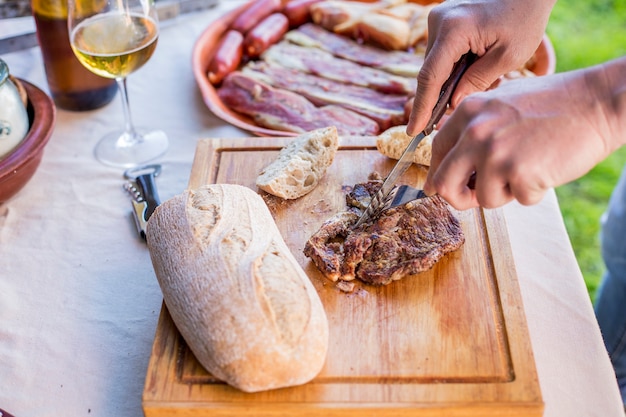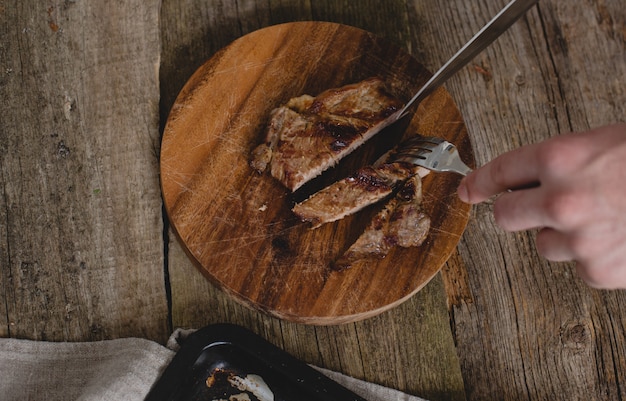(Part 1) Choosing the Right Cut: The Foundation of a Delicious Roast

The Contenders: Exploring the Pork Roast Options
pork shoulder: This is a classic for a reason. It's packed with flavour and gets incredibly tender when cooked low and slow. It's got a nice layer of fat, which adds richness and keeps the meat moist. This is a fantastic choice for a big family gathering because it's very forgiving – it's hard to mess up! pork loin roast: This is a leaner cut, so it needs a bit more care to prevent it from drying out. It's a great option if you're looking for a more delicate roast that melts in your mouth. However, it doesn't have the same deep flavor as the shoulder. pork tenderloin: This is a super tender and lean cut, but it's also a bit more delicate. It's perfect for a smaller gathering or as a side dish, but it won't be as substantial as a shoulder or loin roast.My Personal Pick: A Shoulder, Every Time!
I'm a huge fan of pork shoulder. It's my go-to choice for roast. I love the rich flavour and the way it becomes so tender when cooked slowly. Plus, it's incredibly versatile. You can roast it whole, or you can shred it after cooking for pulled pork sandwiches, tacos, or even salads.(Part 2) Seasoning the Star: Bringing Out the Flavors

The Basics: A Simple Rub for a Classic Roast
Here's my basic go-to rub that always delivers a delicious result: 1 tablespoon salt 1 tablespoon black pepper 1 teaspoon paprika 1/2 teaspoon garlic powder 1/4 teaspoon onion powderMix it all together and rub it generously all over the roast, making sure to get it into all the nooks and crannies. This rub will give the roast a beautiful crust and enhance the natural pork flavor.Beyond the Basics: Adding More Flavor and Depth
Don't be afraid to get creative! Experiment with different herbs like thyme, rosemary, oregano, or even a touch of sage. For a little kick, you can add some chili powder, and if you like things sweet, a bit of brown sugar adds a lovely depth. The possibilities are endless!(Part 3) Prepping for the Roast: Setting the Stage for Success

The Importance of Prepping: A Few Simple Steps Make All the Difference
Prepping might seem like an extra step, but it's crucial! It can be the difference between a dry, uneven roast and a juicy, flavorful one.Tie It Up Tight: Securing the Roast for Even Cooking
If you're working with a pork shoulder, tying it up is a good idea. This helps it cook more evenly, preventing any parts from drying out. You can use kitchen twine for this, or if you're feeling adventurous, you can use a meat thermometer probe to secure it. Just remember to remove the probe before putting it in the oven!A Little Fat is Your Friend: Understanding the Role of Fat
Don't be afraid of the fat on your pork roast. It's actually your friend! It helps to keep the meat moist and tender, and it adds a lot of flavour. Leave a good layer of fat on the roast, especially if you're using a shoulder. It will render as it cooks, basting the meat with delicious juices.(Part 4) The Roast Begins: Choosing Your Cooking Method
Now for the fun part: actually cooking the roast! There are two main methods, each with its own pros and cons.Slow and Steady Wins the Race: The Beauty of Slow Roasting
This is my personal favorite method. You're basically cooking the roast at a low temperature for a longer time, which allows the fat to render and the meat to become incredibly tender. It's perfect for a shoulder because it breaks down the connective tissue, resulting in a melt-in-your-mouth experience.Setting the Stage for Success: Slow roasting tips
Preheat your oven to 325°F (160°C). Place the roast in a roasting pan, fat-side up. Add some liquid to the bottom of the pan, such as water, broth, or even beer. This helps keep the meat moist and creates a flavorful sauce. Cover the pan with foil for the first part of the cooking time. This helps the roast cook evenly and retain moisture. Remove the foil for the last 30 minutes of cooking to allow the roast to brown.Hot and Fast: The Quick and Convenient Option
This method is ideal for busy weeknights. You're cooking the roast at a higher temperature, which reduces the cooking time. It's a good option for a leaner cut like the loin, but remember, it requires a bit more attention to ensure it doesn't dry out.Achieving Perfection with High-Heat Roasting
Preheat your oven to 400°F (200°C). Place the roast in a roasting pan, fat-side up. Add a bit of oil to the bottom of the pan to help the roast brown. Cook for 15-20 minutes per pound, or until a meat thermometer inserted into the thickest part of the roast registers 145°F (63°C). Let the roast rest for 10 minutes before carving.(Part 5) The Crucial Check: Using a Meat Thermometer
No matter which method you choose, a meat thermometer is your best friend. It's the only way to ensure that the roast is cooked through and safe to eat.The Importance of Accuracy: Why a Meat Thermometer Matters
Don't rely on visual cues alone. Pork can look cooked on the outside but still be raw on the inside. A meat thermometer takes the guesswork out of it and gives you peace of mind.The Magic Number: The Safe internal temperature for Pork
The USDA recommends cooking pork to an internal temperature of 145°F (63°C) for at least 15 seconds. This kills any harmful bacteria.How to Use a Meat Thermometer: A Simple Guide
1. Insert the thermometer into the thickest part of the roast, making sure it doesn't touch any bone.2. Leave it in for a few seconds to get an accurate reading.3. If the roast is not yet cooked through, continue cooking until it reaches the desired temperature.(Part 6) The Resting Period: Let the Roast Relax
Your roast is cooked to perfection! Don't rush to carve it right away! Let it rest for at least 10 minutes before slicing into it.The Importance of Resting: Retaining Juices and Enhancing Flavor
While it's tempting to dig in immediately, resist the urge. During the resting time, the juices redistribute throughout the meat, resulting in a much juicier and more flavorful roast.A Warm Embrace: Keeping the Roast Cozy
Cover the roast with aluminum foil while it rests to keep it warm and prevent it from drying out.(Part 7) The Grand Finale: Carving and Serving
The moment of truth has arrived! It's time to carve that beautiful roast!Getting It Right: The Art of Carving a Pork Roast
1. Use a sharp knife: A dull knife will only make things difficult and could lead to uneven slices.2. Slice against the grain: This keeps the meat tender and makes it easier to chew.3. Cut into thin slices: This makes serving and eating much easier.Garnish and Accompaniments: Completing the Feast
Now that your roast is carved, it's time for the finishing touches. Here are some ideas: A touch of greenery: A sprig of rosemary or thyme adds a touch of freshness. A drizzle of pan sauce: The liquid you used to cook the roast can be strained and thickened to create a delicious pan sauce. side dishes: Serve your roast with classic accompaniments like mashed potatoes, roasted vegetables, or a green salad.(Part 8) The Leftovers: Making the Most of Your Pork Roast
You've enjoyed your delicious roast, and you've got leftovers. Don't let them go to waste! There are plenty of ways to use them.Beyond the Roast: Creative Leftover Ideas
Pulled pork sandwiches: Shred the leftover meat and use it to make delicious sandwiches. Pork tacos: Use the meat to make tacos, adding your favorite toppings like salsa, guacamole, and sour cream. Pork soup: Make a hearty pork soup using the leftover meat and vegetables. Pork pasta salad: Mix the meat with pasta, vegetables, and a vinaigrette dressing for a delicious salad.(Part 9) FAQs: Answers to Your Pork Roast Questions
Let's tackle some common questions about cooking a pork roast.Q1: How long does it take to cook a 3-pound pork roast?
A: The cooking time for a 3-pound pork roast will vary depending on the method you choose. For slow roasting, it will take around 3-4 hours. For high-heat roasting, it will take around 45-60 minutes.Q2: What temperature should the pork roast be cooked to?
A: The USDA recommends cooking pork to an internal temperature of 145°F (63°C) for at least 15 seconds.Q3: How do I know if my pork roast is done?
A: The best way to tell if your pork roast is done is to use a meat thermometer. It should register 145°F (63°C) in the thickest part of the roast. You can also check the meat for doneness by poking it with a fork. If the juices run clear, it's done.Q4: Can I overcook a pork roast?
A: Yes, you can overcook a pork roast. If you cook it for too long, it will become dry and tough. That's why using a meat thermometer is so important.Q5: What do I do if my pork roast is overcooked?
A: If your pork roast is overcooked, it's not the end of the world. You can still use it to make pulled pork sandwiches or tacos. You can also add it to soups and stews.Final Thoughts: The Joy of a Perfectly Cooked Pork Roast
There you have it, a complete guide to cooking a 3-pound pork roast. Now, go forth and conquer the kitchen! Remember, it's all about having fun and experimenting with different flavours. And don't forget to share your delicious creations with your loved ones. After all, there's nothing quite like enjoying a juicy, tender pork roast with good company. Happy cooking!Everyone is watching

How to Cook Frozen Lobster Tails Perfectly: A Step-by-Step Guide
RecipesLobster. Just the word conjures up images of lavish meals, special occasions, and a taste of luxury. But let's...

Pigs in a Blanket Cooking Time: How Long to Bake for Perfect Results
RecipesAh, pigs in a blanket. Just the name conjures up images of those delightful little parcels of crispy pastry en...

Pork Fillet Cooking Time: How Long to Cook It Perfectly
RecipesPork fillet, or tenderloin as it's sometimes called, is a real favourite in our house. It's so versatile, and...

The Ultimate Guide to Cooking Delicious Frankfurters
RecipesLet's face it, we all love a good frankfurter. It's a classic, simple, and always satisfying. But let's be rea...

Wolf Meat Recipes: A Guide to Cooking Wild Game
RecipesLet's be honest, you don't see wolf meat at your local butcher shop every day. It's a bit of a wild card, but ...
